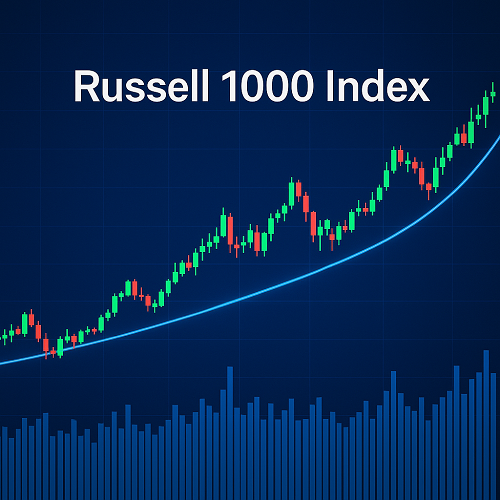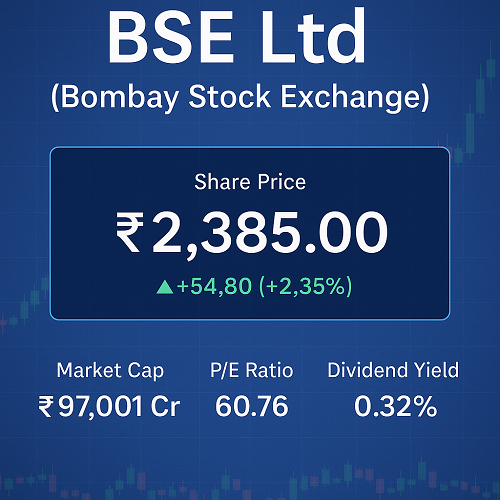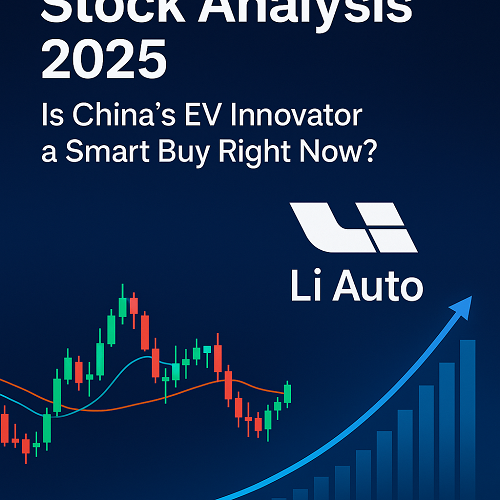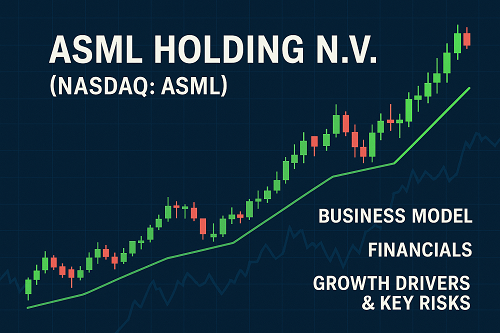The Russell 1000 Index stands as one of the most recognized benchmarks for U.S. large-cap equities. Representing roughly 92% of the total U.S. market capitalization, this index serves as a vital barometer for institutional investors, portfolio managers, and individual traders seeking exposure to the largest and most stable companies in America.
Comprising the 1,000 largest U.S. companies within the broader Russell 3000 Index, the Russell 1000 tracks blue-chip leaders that collectively shape the direction of the U.S. economy. From tech titans and consumer giants to financial institutions and industrial stalwarts, this index defines what “large-cap” truly means.
In this comprehensive guide, we’ll break down how the Russell 1000 is constructed, how it differs from other major indices like the S&P 500 and Russell 2000, how investors use it for benchmarking and investing, and what makes it one of the most respected gauges in modern finance.
What Is the Russell 1000 Index?
The Russell 1000 Index is a market capitalization-weighted index that captures the 1,000 largest publicly traded companies in the U.S. equity market. It’s maintained by FTSE Russell, a division of the London Stock Exchange Group (LSEG), and is widely used by asset managers to measure and benchmark performance in the large-cap segment.
Core Characteristics
- Constituents: 1,000 largest U.S. companies by market cap
- Coverage: ~92% of the total U.S. equity market
- Weighting method: Free-float market capitalization
- Update frequency: Reconstituted annually in June
- Parent index: Russell 3000 Index
Purpose
The index is designed to provide a comprehensive and unbiased representation of U.S. large-cap equities, ensuring that investment managers have a reliable tool to compare fund performance, analyze market trends, and build passive investment products.
Methodology and Index Construction
The Russell 1000 uses a rules-based, transparent methodology rather than a committee-selected approach, setting it apart from indices like the S&P 500. This methodology ensures objectivity and consistency across reconstitutions.
Selection Process
- Universe Definition:
Starts with the Russell 3000E, encompassing the largest 4,000 U.S. stocks by market capitalization. - Ranking:
Companies are ranked by their total market cap as of the last trading day in May. - Cutoff:
The top 1,000 are placed into the Russell 1000, while the next 2,000 form the Russell 2000 (small-cap index). - Weighting:
Each constituent is weighted by its free-float-adjusted market cap. - Reconstitution:
Occurs annually in late June, ensuring the index remains an accurate reflection of the large-cap landscape.
Why This Matters
This objective, data-driven ranking system eliminates potential biases found in committee-based indices. It ensures that any eligible company — regardless of sector or reputation — can enter the index purely based on size and liquidity.
Key Features and Benefits
The Russell 1000 offers several defining advantages for investors and market participants:
Comprehensive Market Representation
By encompassing nearly the entire large-cap universe, the Russell 1000 provides a broader scope than the S&P 500, which captures only around 80% of U.S. market capitalization.
Transparency and Consistency
Its rules-based approach ensures a consistent methodology, offering investors confidence that index changes are predictable and data-driven.
Integration With Other Russell Indices
The Russell 1000 is part of the Russell U.S. Index family, which includes:
- Russell 2000 – small-cap stocks
- Russell 3000 – total market
- Russell Midcap – subset of mid-cap stocks
These indices combine seamlessly, allowing investors to analyze and allocate capital across the entire market spectrum.
Institutional Credibility
Used by thousands of institutional investors and fund managers worldwide, the Russell 1000 serves as a benchmark for trillions of dollars in assets under management (AUM).
Performance and Historical Context
While past performance doesn’t guarantee future results, understanding historical trends helps investors assess index behavior.
Historical Returns (Approximate Annualized as of 2025)
| Time Period | Russell 1000 Return | S&P 500 Return |
|---|---|---|
| 1 Year | 25.1% | 24.3% |
| 5 Years | 13.4% | 13.2% |
| 10 Years | 12.2% | 12.0% |
| 20 Years | 9.4% | 9.2% |
Both indices perform closely, but the Russell 1000 often edges slightly higher due to its inclusion of additional large and mid-cap stocks not present in the S&P 500.
Volatility & Risk
The Russell 1000 tends to have slightly lower volatility than small-cap indices, offering more stability during downturns and steady compounding over the long term.
Market Leadership
Tech giants such as Apple, Microsoft, Amazon, NVIDIA, and Alphabet dominate the top weights, reflecting the concentration trend in modern equity markets.
Sector Composition (2025 Snapshot)
| Sector | Weight (%) |
|---|---|
| Information Technology | 29.5 |
| Financials | 13.8 |
| Health Care | 12.1 |
| Consumer Discretionary | 10.6 |
| Communication Services | 8.9 |
| Industrials | 8.2 |
| Consumer Staples | 6.3 |
| Energy | 3.5 |
| Utilities | 2.4 |
| Real Estate | 2.2 |
| Materials | 2.0 |
The dominance of technology and financials reflects current U.S. market realities — the Russell 1000 closely tracks macroeconomic trends through sector rotation.
Top 10 Constituents (as of 2025)
| Rank | Company | Ticker | Sector | Index Weight (%) |
|---|---|---|---|---|
| 1 | Apple Inc. | AAPL | Technology | 6.5 |
| 2 | Microsoft Corp. | MSFT | Technology | 6.0 |
| 3 | Amazon .com Inc. | AMZN | Consumer Discretionary | 4.7 |
| 4 | NVIDIA Corp. | NVDA | Technology | 4.2 |
| 5 | Alphabet Inc. A | GOOGL | Communication Services | 3.1 |
| 6 | Meta Platforms Inc. | META | Communication Services | 2.5 |
| 7 | Berkshire Hathaway Inc. | BRK.B | Financials | 2.1 |
| 8 | Tesla Inc. | TSLA | Consumer Discretionary | 1.9 |
| 9 | UnitedHealth Group | UNH | Health Care | 1.6 |
| 10 | JPMorgan Chase & Co. | JPM | Financials | 1.4 |
These top 10 firms account for over one-third of the index’s total weight, underscoring the growing dominance of mega-caps.
How Investors Use the Russell 1000 Index
1. Benchmarking
Fund managers use the index to measure performance of large-cap portfolios, mutual funds, and institutional mandates.
2. Passive Investing
A variety of ETFs and index funds track the Russell 1000, offering low-cost exposure.
Popular examples:
- iShares Russell 1000 ETF (IWB)
- Vanguard Russell 1000 ETF (VONE)
- SPDR Russell 1000 ETF (ONEK)
3. Style Segmentation
FTSE Russell also publishes Russell 1000 Growth and Russell 1000 Value variants, enabling investors to target specific styles based on fundamentals like earnings growth or book-to-price ratios.
4. Derivatives and Structured Products
The index underpins futures, options, and swaps, allowing for efficient hedging, tactical allocation, or synthetic replication by institutions.
Russell 1000 vs Other Major Indices
| Feature | Russell 1000 | S&P 500 | Russell 2000 |
|---|---|---|---|
| Constituents | 1,000 | 500 | 2,000 |
| Market Coverage | ~92% | ~80% | ~8% |
| Methodology | Rules-based | Committee-selected | Rules-based |
| Focus | Large + mid-cap | Large cap | Small cap |
| Reconstitution | Annual (June) | Ongoing (discretionary) | Annual (June) |
The Russell 1000 provides broader exposure than the S&P 500 by including mid-cap stocks that may become tomorrow’s large-caps. This characteristic often leads to better diversification and slightly higher growth potential.
Challenges and Limitations
Even highly regarded indices have drawbacks:
- Mega-Cap Concentration:
The top 10 stocks dominate total weighting, reducing diversification benefits. - Reconstitution Turnover:
Annual reshuffling can trigger trading costs for funds replicating the index. - Market-Cap Weighting Bias:
Heavily favors already successful companies, potentially overexposing investors to momentum risk. - Sector Imbalances:
Tech’s oversized role can magnify drawdowns during sector rotations. - Limited Small-Cap Exposure:
Excludes emerging growth companies that drive innovation.
Understanding these nuances allows investors to adjust exposure or complement Russell 1000 holdings with other indices (e.g., Russell 2000 or equal-weight indices).
Recent Trends Affecting the Russell 1000
- Rise of Mega-Caps:
Companies like Apple, Microsoft, and NVIDIA now account for unprecedented index share, creating a “narrow market” dynamic. - AI and Technology Dominance:
Artificial intelligence and semiconductor stocks are redefining the growth landscape within the index. - Interest Rate Shifts:
Higher rates influence valuation multiples; large-cap quality stocks often outperform during tightening cycles. - ESG Integration:
FTSE Russell has introduced ESG-focused variants, such as the Russell 1000 ESG Index, catering to sustainability-minded investors. - Globalization & Supply Chain Reorientation:
Large-cap industrials and energy firms are benefiting from reshoring and infrastructure initiatives.
How to Invest in the Russell 1000
Investors can access exposure through:
| Vehicle | Example | Expense Ratio |
|---|---|---|
| ETF | iShares Russell 1000 (IWB) | 0.15% |
| ETF | Vanguard Russell 1000 (VONE) | 0.08% |
| Mutual Fund | Russell 1000 Index Fund (Various providers) | 0.10%–0.20% |
| Futures | CME Russell 1000 Futures | Variable |
Tips for investors:
- Evaluate tracking error between ETF and index.
- Consider liquidity and spread costs.
- Review style preference (Growth vs Value).
- Use tax-efficient accounts for long-term holding.
FAQs
Q1: What’s the difference between the Russell 1000 and Russell 3000?
The Russell 1000 is a subset of the broader Russell 3000, which includes both large- and small-cap stocks. The top 1,000 by market cap make up the Russell 1000; the next 2,000 form the Russell 2000.
Q2: How often is the Russell 1000 updated?
It’s reconstituted annually in June, though corporate actions (mergers, delistings, etc.) trigger interim adjustments.
Q3: Is the Russell 1000 better than the S&P 500?
Not necessarily — but it’s broader and more systematic. Many investors prefer it for its rules-based transparency and inclusion of mid-cap names.
Q4: Can I invest directly in the index?
No. Investors can only access it indirectly via ETFs, index funds, or derivatives that track the index.
Q5: What companies are in the Russell 1000?
The full list is published annually by FTSE Russell and includes the 1,000 largest U.S. firms by market capitalization.
Conclusion
The Russell 1000 Index is more than just a market gauge — it’s the foundation of U.S. large-cap investing. Its comprehensive coverage, transparent methodology, and deep institutional adoption make it indispensable for understanding and navigating the equity landscape.
Whether you’re a passive investor seeking stable exposure or a professional manager benchmarking fund performance, the Russell 1000 remains an unmatched standard for measuring large-cap U.S. market behavior.
As markets evolve and mega-caps shape the next decade, the Russell 1000 continues to stand as the definitive snapshot of America’s corporate elite — a mirror reflecting the dynamic heartbeat of U.S. capitalism.





 XAUT-USD
XAUT-USD  AMD
AMD  MARA
MARA  SHOP
SHOP  BULL
BULL  CL=F
CL=F